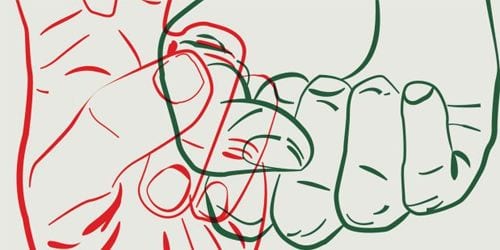
Between 1965 and 1969, the number of underground newspapers ballooned from five in as many US cities to over 500 around the world. These papers networked outside the establishment, sharing content with each other, and became a critical element of the counterculture. The underground fanzines that flourished in the ’80s and their grown up counterpart, the free alternative weekly, can be trace their origins back to this fairly small space in time.
On The Ground: An Illustrated Anecdotal History of the Sixties Underground Press In the U.S. provides readers with a glance backward at the publications that set the pace for the rest. Editor Sean Stewart writes that the book is as much about the look of the publications in question as it is about the writing. He notes that the project grew in part out of an exhibit he held at the San Francisco-based bookstore and gallery Babylon Falling, at which the audience was able to see many of these papers and hear stories from the veterans of the respective scenes that gave rise to the publications. The stated drive is for “anecdotal detail” and “atmospherics” rather than a comprehensive or official history.
It’s in the execution of those intentions where the book both fails and succeeds in extremes.
We do get a strong sense of the day-to-day life in the underground, and those of us who have worked at small weeklies will be able to attest to the glory and the grind that that job brings. The greats captured in these pages include Paul Krassner (The Realist), Art Kunkin (Los Angeles Free Press), John Sinclair (Fifth Estate, Ann Arbor Sun), Emory Douglas (The Black Panther), and artist Trina Robbins (East Village Other, It Ain’t Me, Babe). Each shares stories of trouble with “the heat”, as well as their respective publication’s audience and content, and how each rose and fell.
In addition to the works listed above there are page reproductions from The Rag (Austin, Texas), Seed (Chicago), Rat Subterranean News (New York City), and Space City! (Houston). Some look like traditional newspapers (Los Angeles Free Press) while others (Rat Subterranean News) are closer to the comix (It Ain’t Me Babe and Slow Death Funnies) represented here.
But the overall narrative remains weak. The book falls victim to the same problem many oral histories suffer from: there’s no authoritative glue holding together the parts the average reader may not already know, and thus the story starts and stops but never really finds a noteworthy conclusion. One of the tricks of presenting interviews is knowing what to leave in, what to leave out, and when to cut from one voice to another in order that one might enhance dramatic action.
But here the individual stories are presented like fresh conversation, with all the gaps in logic and associative leaps of that medium, creating a disjointed feel and seriously hindering the dramatic arc. Rather than feeling as though you’re listening to a fascinating yarn, you feel instead that you’ve eavesdropped on one too many conversations at party.
The stories of unity and the importance that these publications had in the youth movement, the Black Power movement, and the drug culture cannot be underestimated. The political theatre carried out in the pages of these publications––and, sometimes, in their name––remains a unique moment in American publishing and one that may become increasingly relevant in coming years as who delivers the news and how they deliver it continues to rapidly evolve.
Stewart cites several critical pieces in the underground newspaper story in his introduction, including John McMillian’s Smoking Typewriters: The Sixties Underground Press and the Rise of Alternative Media in America, Laurence Leamer’s The Paper Revolutionaries, and Patrick Rosenkranz’s Rebel Visions: The Underground Comix Revolution. Some of those do offer a more comprehensive story about the underground press, but the greatest book on this topic has not yet been written.

![Call for Papers: All Things Reconsidered [MUSIC] May-August 2024](https://www.popmatters.com/wp-content/uploads/2024/04/all-things-reconsidered-call-music-may-2024-720x380.jpg)



